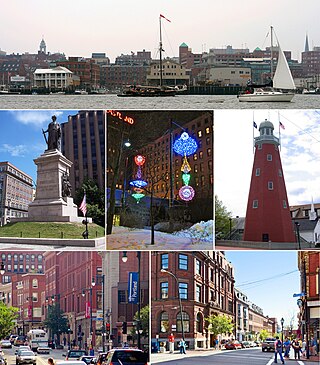
Portland is the most populous city in the U.S. state of Maine and the seat of Cumberland County. Portland's population was 68,408 in April 2020. The Greater Portland metropolitan area has a population of approximately 550,000 people. Historically tied to commercial shipping, the marine economy, and light industry, Portland's economy in the 21st century relies mostly on the service sector. The Port of Portland is the second-largest tonnage seaport in the New England area as of 2019.

Portland Head Light is a historic lighthouse in Cape Elizabeth, Maine. The light station sits on a head of land at the entrance of the primary shipping channel into Portland Harbor, which is within Casco Bay in the Gulf of Maine. Completed in 1791, it is the oldest lighthouse in Maine. The light station is automated, and the tower, beacon, and foghorn are maintained by the United States Coast Guard, while the former lighthouse keepers' house is a maritime museum within Fort Williams Park.

The Wadsworth-Longfellow House is a historic house and museum in Portland, Maine, United States. It is located at 489 Congress Street and is operated by the Maine Historical Society. It was designated a National Historic Landmark in 1962, and administratively added to the National Register of Historic Places in 1966. The house is open daily to public from May through October. An admission fee is charged.

The Tate House is a historic house museum at 1270 Westbrook Street, near the Fore River in the Stroudwater neighborhood of Portland, Maine, United States. The house, one of the oldest in Portland, was built in 1755 for George Tate, a former Royal Navy captain who was sent by a contractor to the Navy to oversee the felling and shipment of trees for use as masts. Because of the house's comparatively remote location away from central Portland, it survived Portland's numerous fires intact. The house was designated a National Historic Landmark as a rare surviving example of a once-common colonial housing form, the clerestory gambrel roof. Since 1935 it has been a museum operated by the National Society of the Colonial Dames.
Kennedy Park is a neighborhood in East Bayside in downtown Portland, Maine, built around a park, athletic fields, basketball courts, a playground and the Boyd Street Urban Garden.
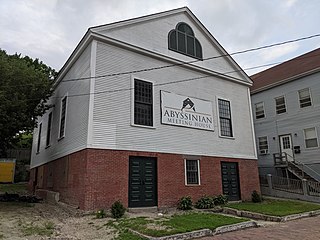
The Abyssinian Meeting House is a historic church building at 73–75 Newbury Street, in the Munjoy Hill neighborhood of Portland, Maine. Built 1828-1831 by free African-Americans, it is Maine's oldest African-American church building, and the third oldest in the nation. Throughout the years, the Abyssinian was a place for worship and revivals, abolition and temperance meetings, speakers and concerts, the Female Benevolent Society, the Portland Union Anti-Slavery Society and negro conventions, and the black school in Portland from the mid-1840s through the mid-1850s. The building is the only Underground Railroad site in Maine recognized by the National Park Service. It was listed on the National Register of Historic Places in 2006.

This is a list of the National Register of Historic Places listings in York County, Maine.

The United States Custom House is a historic custom house at 312 Fore Street in downtown Portland, Maine. It was built from 1867–1872 to house offices of the United States Customs Service, and was listed on the National Register of Historic Places in 1973.

Mariner's Church is a historic church and commercial building at 368-374 Fore Street in Portland, Maine. Built in 1828, the Greek Revival building historically served as both a church and marketplace. It was for many years the city's largest commercial building, and survived the city's great 1866 fire. It was listed on the National Register of Historic Places in 1973. It is now home to the Old Port Tavern and other commercial businesses.
Portland, Maine, is home to many neighborhoods.
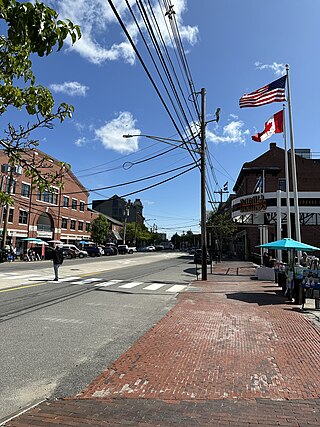
Commercial Street is a downtown street in the Old Port of Portland, Maine, United States. It is part of U.S. Route 1A. It became the Old Port's waterfront in the early 20th century, replacing Fore Street, after land was reclaimed from the waters of Casco Bay and the Fore River.
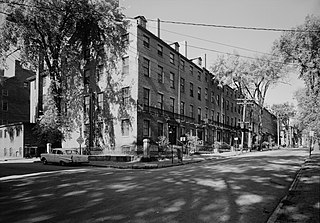
The Park Street Row, also known as Park Street Block, is a set of historic rowhouses at 88–114 Park Street, in Portland, Maine. Built in 1835, it is the largest known 19th-century rowhouse in the state, and is a local example of Greek Revival architecture. It was added to the National Register of Historic Places in 1972.
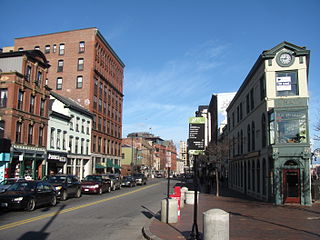
Congress Street is the main street in Portland, Maine. Congress stretches from Portland's southwestern border with Westbrook through a number of neighborhoods before ending overlooking the Eastern Promenade on Munjoy Hill. In March 2009, the Portland City Council designated much of the inner portion of Congress Street a historic district. The western section of the street includes the city's Arts District.

The Press Herald Building is an historic building in Portland, Maine, built in 1923 and expanded in 1948. It is strategically located across Congress Street from Portland City Hall. It was occupied by the Portland Press Herald newspaper until 2010. In 2015, the renovated building reopened as the Press Hotel.
The Hollow Reed was a vegetarian restaurant in the Old Port district of Portland, Maine. It opened on February 7, 1974, and closed in 1981, and is cited for its influence on the city's notable restaurant culture.
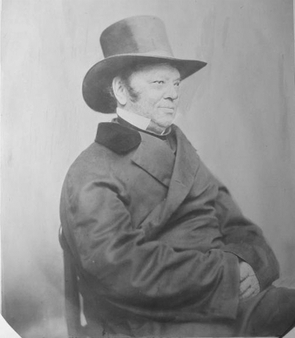
Charles Quincy Clapp was a prominent American merchant and architect in Portland, Maine. He was active in the first half of the 19th century.

The PortlandFreedom Trail is a self-guided walking tour of Portland, Maine. Established in 2007, its 2-mile (3.2 km) course passes through the city's oldest and most historic areas, including those related to its African American population, and features thirteen points of interest. Most of the stops are in the Old Port and Arts District. The Abyssinian Meeting House, the third-oldest African American meetinghouse in the country, is a stop on the tour, while several others are tied to the city's former Underground Railroad.
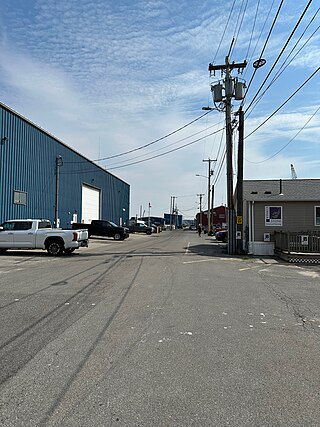
Union Wharf is a historic wharf in Portland, Maine. It stands across Commercial Street from Union Street and, on the waterfront side, between Widgery Wharf and Merrill's Wharf, on the edge of the Fore River.
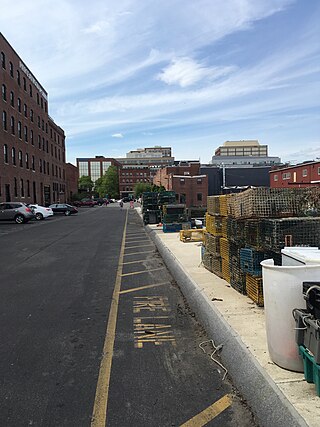
Merrill's Wharf is a historic wharf in Portland, Maine, on the edge of the Fore River. It stands across Commercial Street from Cross Street and, on the waterfront side, between Union Wharf and the Portland Fish Pier. It was formerly known as Dana's Wharf.

Fore Street is a downtown street in Portland, Maine, United States. It runs for around 1 mile (1.6 km), from the Eastern Promenade on Munjoy Hill in the northeast to Pleasant Street in the southwest. Near its midsection, Fore Street crosses Franklin Street. It splits briefly at Boothby Square, shortly after passing the United States Custom House. The street passes through the Old Port district.

















